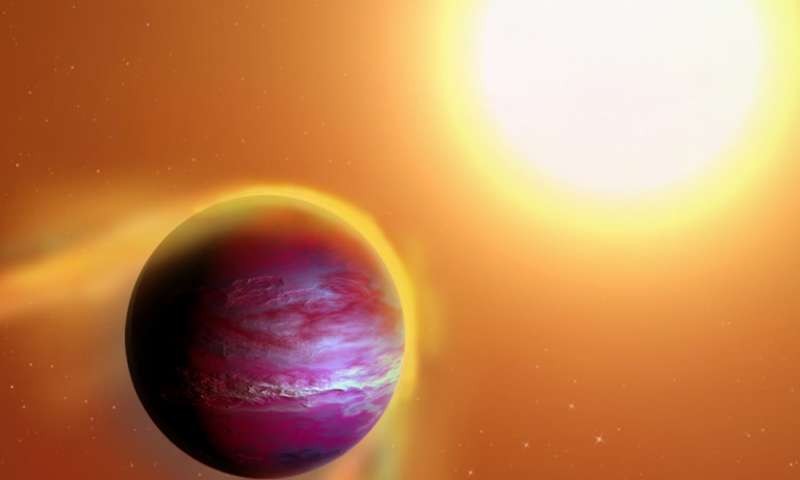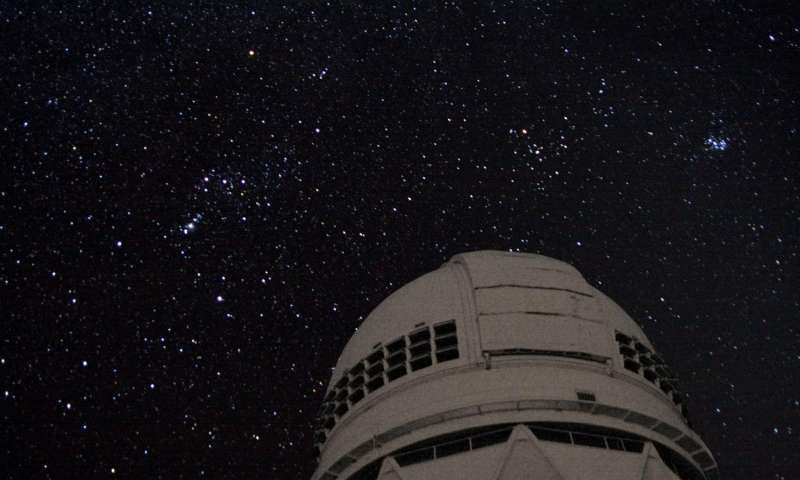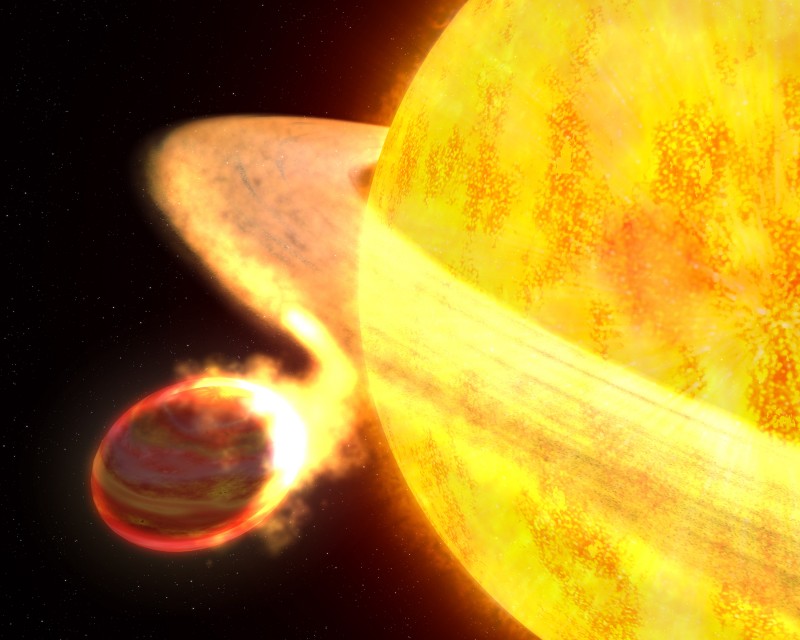 |
| An artist's impression of likely new giant planet PTFO8-8695 b, which is believed to orbit a star in the constellation Orion every 11 hours. Gravity from the newborn star appears to be pulling away the outer layers of the Jupiter-like planet. Credit: . Passwaters/Rice University based on original available under CC license on Wikipedia |
Astronomers searching for the galaxy's youngest planets have found compelling evidence for one unlike any other, a newborn "hot Jupiter" whose outer layers are being torn away by the star it orbits every 11 hours.
"A handful of known planets are in similarly small orbits, but because this star is only 2 million years old this is one of the most extreme examples," said Rice University astronomer Christopher Johns-Krull, lead author of a new study that makes a case for a tightly orbiting gas giant around the star PTFO8-8695 in the constellation Orion. The peer-reviewed study will be published in The Astrophysical Journal and was made available online this week.
"We don't yet have absolute proof this is a planet because we don't yet have a firm measure of the planet's mass, but our observations go a long way toward verifying this really is a planet," Johns-Krull said. "We compared our evidence against every other scenario we could imagine, and the weight of the evidence suggests this is one of the youngest planets yet observed."
Dubbed "PTFO8-8695 b," the suspected planet orbits a star about 1,100 light years from Earth and is at most twice the mass of Jupiter. The team that compiled the evidence was co-led by Johns-Krull and Lowell Observatory astronomer Lisa Prato and included 10 co-authors from Rice, Lowell, the University of Texas at Austin, NASA, the California Institute of Technology and Spain's National Institute of Aerospace.
"We don't know the ultimate fate of this planet," Johns-Krull said. "It likely formed farther away from the star and has migrated in to a point where it's being destroyed. We know there are close-orbiting planets around middle-aged stars that are presumably in stable orbits. What we don't know is how quickly this young planet is going to lose its mass and whether it will lose too much to survive."
Astronomers have discovered more than 3,300 exoplanets, but almost all of them orbit middle-aged stars like the sun. On May 26, Johns-Krull, Prato and co-authors announced the discovery of 'CI Tau b,' the first exoplanet found to orbit a star so young that it still retains a disk of circumstellar gas. Johns-Krull said finding such young planets is challenging because there are relatively few candidate stars that are young enough and bright enough to view in sufficient detail with existing telescopes. The search is further complicated by the fact that young stars are often active, with visual outbursts and dimmings, strong magnetic fields and enormous starspots that can make it appear that planets exist where they do not.
PTFO8-8695 b was identified as a candidate planet in 2012 by the Palomar Transit Factory's Orion survey. The planet's orbit sometimes causes it to pass between its star and our line of sight from Earth, therefore astronomers can use a technique known as the transit method to determine both the presence and approximate radius of the planet based on how much the star dims when the planet "transits," or passes in front of the star.
 |
| The Orion constellation as seen over the Mayall 4-meter Telescope on Kitt Peak. Christopher Johns-Krull. Credit: Jeff Fitlow/Rice University Credit: J. Glaspey/NOAO/AURA/NSF |
"In 2012, there was no solid evidence for planets around 2 million-year-old stars," Prato said. "Light curves and variations of this star presented an intriguing technique to confirm or refute such a planet. The other thing that was very intriguing about it was that the orbital period was only 11 hours. That meant we wouldn't have to come back night after night after night, year after year after year. We could potentially see something happen in one night. So that's what we did. We just sat on the star for a whole night."
A spectroscopic analysis of the light coming from the star revealed excess emission in the H-alpha spectral line, a type of light emitted from highly energized hydrogen atoms. The team found that the H-alpha light is emitted in two components, one that matches the very small motion of the star and another than seems to orbit it.
"We saw one component of the hydrogen emission start on one side of the star's emission and then move over to the other side," Prato said. "When a planet transits a star, you can determine the orbital period of the planet and how fast it is moving toward you or away from you as it orbits. So, we said, 'If the planet is real, what is the velocity of the planet relative to the star?' And it turned out that the velocity of the planet was exactly where this extra bit of H-alpha emission was moving back and forth."
Johns-Krull said transit observations revealed that the planet is only about 3 to 4 percent the size of the star, but the H-alpha emission from the planet appears to be almost as bright as the emission coming from the star.
"There's no way something confined to the planet's surface could produce that effect," he said. "The gas has to be filling a much larger region where the gravity of the planet is no longer strong enough to hold on to it. The star's gravity takes over, and eventually the gas will fall onto the star."
